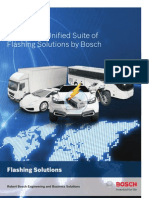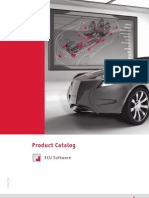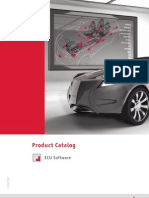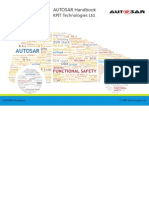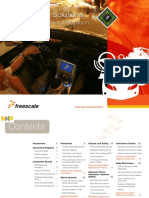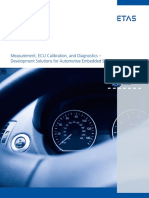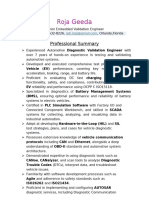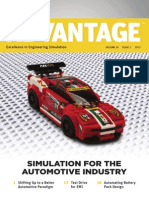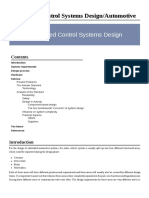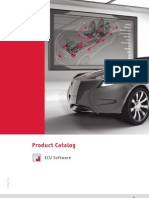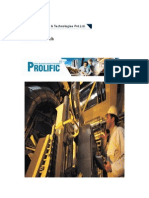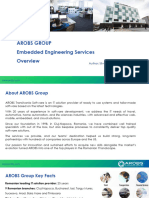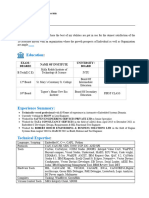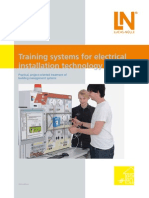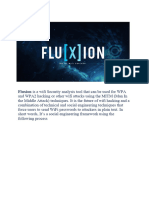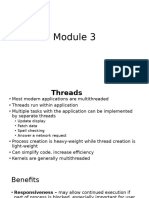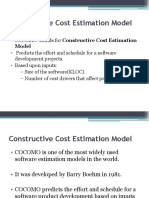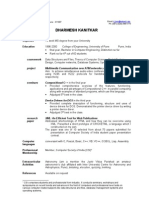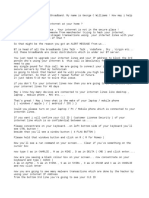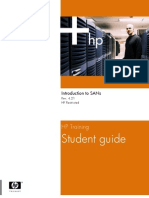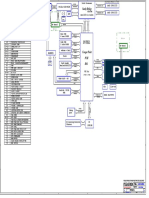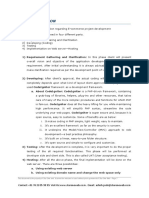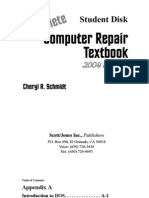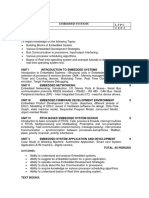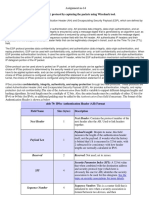Ibmautomtive
Ibmautomtive
Uploaded by
Meltz NjorogeCopyright:
Available Formats
Ibmautomtive
Ibmautomtive
Uploaded by
Meltz NjorogeOriginal Title
Copyright
Available Formats
Share this document
Did you find this document useful?
Is this content inappropriate?
Copyright:
Available Formats
Ibmautomtive
Ibmautomtive
Uploaded by
Meltz NjorogeCopyright:
Available Formats
Dr.
Udo Brockmeyer, CEO, BTC Embedded Systems AG
Challenges and solutions for developing safety
critical automotive software in compliance with
ISO 26262
Moderator:
Curt Schwaderer, Technology Editor, OpenSystems Media
Speakers:
Agenda
Housekeeping
Presentation
Questions and Answers
Wrap-up
2014 IBM Corporation
Challenges and solutions for developing
safety critical automotive software in
compliance with ISO 26262
2013 IBM Corporation
Software and Systems Engineering | Rational
Agenda
Functional Safety
ISO 26262
Model Driven System Development (MDSD) and Model Based
Testing (MBT)
Development and Testing of Safety-Critical Software
IBM Rational Rhapsody Reference Workflow
Qualification of Software Tools
2014 IBM Corporation
2013 IBM Corporation
Software and Systems Engineering | Rational
Business and Market Drivers
Are Leading to Increased Electronic and Embedded (E/E) Software Content
Green
Hybrid
Electric
Product
Differentiation
Innovation
Brand Image
Growing
Customer
Demands
Comfort
Telematics
Competition
Overcapacity
Price Wars
Legal
Requirements
Safety
Environment
Increased usage of electronics and embedded software;
Highly sophisticated in-vehicle electric/electronic (E/E) systems
INSTRUMENTED INTERCONNECTED INTELLIGENT
2014 IBM Corporation
2013 IBM Corporation
Software and Systems Engineering | Rational
Because of E/E vehicles became instrumented, interconnected and
intelligent over the last 30 years
1980 1990 2000 2010 2020
Engine management
ABS
Digital dashboard
Electronic seats /
doors
Automated climate
control
Safety sensors
Door
Brake Engin
e
Instru
ment
Gearb
ox
ECU
Dynamic Damping Control
Brake Energy Regeneration
Integral Active Steering
Electrically controlled air vents
Night Vision
Lane Departure Warning
Lane Change Warning
Adaptive Headlights
Head-Up Display
Active Cruise Control
Camera systems
Driver assistant systems
engine ECU chassis ECU
safety ECU
brake ECU
Infotain-
ment ECU
instrument
ECU
door ECU
gateway ECU
Intelligent Vehicles
Increasing levels of
electrification
Intersection control violations
Lane/road departure
Road surface and pavement
conditions
360/distance vision
Active suspension and
stability control
Dynamic route guidance /
navigation
Motorist information
Data downloads
Recovery of stolen vehicles
Electronic payments
Ignition
Engine controls
Instrumentation
Engine
S
o
f
t
w
a
r
e
F
u
n
c
t
i
o
n
a
l
i
t
y
a
n
d
A
m
o
u
n
t
10 k
LOC
100 k
LOC
1 M
LOC
10 M
LOC
2014 IBM Corporation
2013 IBM Corporation
Software and Systems Engineering | Rational
Electric and Electronic (E/E) systems are realizing automotive product
innovation
C
ECU
Domain
Vehicle
Software -
Komponente
Software -
Subsystem
Software
Issues with the complexity of automotive Electrical
and Electronic systems
Typically 50 + ECUs, 8 Buses of 4 different
types, Network controllers
Diagram schematics for most vehicles now resemble
small modern aircraft with a similar amount of code
and its inherent complexity
Embedded systems are being used to
Implement more and more advanced features
Improve safety (although this adds complexity
and leads to other issues)
How can you ensure that a possible
malfunction will not harm the driver,
occupants or road users?
A safety approach is needed
2014 IBM Corporation
2013 IBM Corporation
Software and Systems Engineering | Rational
What is Safety?
Safety in the context of automotive embedded
systems is about the prevention, detection, and
response to unintended behavior that can lead to
harm for the vehicle occupants and other road
user
Obvious examples:
anti-lock brakes, air bags, traction control, electronic cruise control, adaptive cruise
control, collision avoidance, lane change control
Less obvious examples:
front windshield defroster/defogger, rear windshield (backlite) defroster, auto-on
headlamps, auto-on running lights, seat-belt pre-tensioners, low tire pressure
warning system, engine, electric-assist power steering.
2014 IBM Corporation
2013 IBM Corporation
Software and Systems Engineering | Rational
What is ISO 26262
ISO 26262 (derived from principles in IEC 61508)
Functional Safety for E/E Systems in Road vehicles (<3.5 tonnes), i.e. Automotive
as opposed to Trucks and Buses
Covers the management and technical aspects of the complete safety development
lifecycle
Takes a risk-based approach for determining risk classes (Automotive Safety
Integrity Levels, ASILs).
Definition of optional, recommended and highly recommended methods for
development activities within system-, hardware and software development
depending on defined ASIL
Design safety into the system from the outset
ISO 26262 covers the complete development lifecycle from Lust to Dust
2014 IBM Corporation
2013 IBM Corporation
Software and Systems Engineering | Rational
What ISO 26262 means for Automotive
All Automotive System development for Electronic and Electrical components need to comply
to ISO 26262
Consists of 10 parts
Due to the reuse of a large number of existing elements and pre-existing vehicle architectures the
development cycle is seldom a pure top down V-cycle
Means that the safety-lifecycle must be adaptable and flexible
Heavily influenced by the V-model
Made more modular
2014 IBM Corporation
2013 IBM Corporation
Software and Systems Engineering | Rational
Rational Method Composer
Rational Team Concert
Use modeling to validate requirements, architecture and
design earlier in the development process including
Simulink integration, autocode generation and automated
test case generation; use in the same way models for
FMEA, FTA
Rational
Rhapsody
Manage system requirements
with complete traceability
across the product lifecycle
Rational
DOORS
Automate quality and test
management with an
integrated, lifecycle-based
testing process
Rational Quality Manager
Rational Test Conductor
Rational Test RealTime
Manage collaborative systems lifecycle management across development teams and engineering
disciplines with Automotive data model based on AUTOSAR & ISO26262 process template and
compliance
A look to the inside: How IBM Rational Software Platform for
Automotive Systems supports ISO 26262
2014 IBM Corporation
IBM Software Group | Rational software
2011 IBM Corporation
2012 IBM Corporation
The Premier Event for Software and Systems Innovation
Rational Method Composer
Rational Team Concert
Rational
Rhapsody
Rational
DOORS
Rational Quality Manager
Rational Test Conductor
Rational Test RealTime
A look to the inside: How IBM Rational Software Platform for
Automotive Systems supports ISO 26262
Software Development and Testing with
IBM
Rational
Rhapsody
and IBM
Rational
Rhapsody
TestConductor Add On
(Model Driven System Development (MDSD) and Model Based Testing (MBT))
IBM Software Group | Rational software
2011 IBM Corporation
2012 IBM Corporation
The Premier Event for Software and Systems Innovation
What is Model Driven Systems Development (MDSD)?
A structured approach for the development of complex systems
across the mechanical, electronic and software disciplines
Ensures that all requirements are fulfilled
Employs models as the primary artifacts throughout systems development
Facilitates improved communication among all stakeholders
Provides a disciplined way to manage complexity through abstraction
Improves quality through integration of testing with development
Allows specification and development of software that controls the system and
enables its use
IBM Software Group | Rational software
2011 IBM Corporation
2012 IBM Corporation
The Premier Event for Software and Systems Innovation
Allowing abstraction, hierarchies and modularization with domain-
focused, standards-based languages
Requirements
Capture &
Analysis
Systems
Analysis &
Design
System
Acceptance
(Sub-)System
Integration &
Test
Module
Integration &
Test
SW Design
SW
Implementation
& Unit Test
Requirements
Requirements
Capture &
Analysis
Systems
Analysis &
Design
System
Acceptance
(Sub-)System
Integration &
Test
Module
Integration &
Test
SW Design
SW
Implementation
& Unit Test
Requirements
Capture &
Analysis
Requirements
Capture &
Analysis
Systems
Analysis &
Design
Systems
Analysis &
Design
System
Acceptance
System
Acceptance
(Sub-)System
Integration &
Test
(Sub-)System
Integration &
Test
Module
Integration &
Test
Module
Integration &
Test
SW Design
SW
Implementation
& Unit Test
Requirements
SysML Systems Modeling
Language for modeling high-level
vehicle functions
logical and technical
architecture
vehicle and E/E system
behavior
UML Unified Modeling Language
for modeling
ECU and SW architecture
Client-specific profiles
AUTOSAR
Detailed E/E System and ECU HW and
SW architecture
IBM Software Group | Rational software
2011 IBM Corporation
2012 IBM Corporation
The Premier Event for Software and Systems Innovation
Extend requirements engineering
to development
Traceability and more
Use models for Safety Analysis
Focus on analysis and design
From system down to software
Execute models
Analyze behavior
Find errors early
Develop highly-optimized embedded C/C++/Java software
Model and Code are kept in sync
Collaborate visually
Integrated in the IBM Rational Software Platform for Automotive Systems
MDSD Benefit with IBM Rational Rhapsody
Requirements
Capture &
Analysis
Systems
Analysis &
Design
System
Acceptance
(Sub-)System
Integration &
Test
Module
Integration &
Test
SW Design
SW
Implementation
& Unit Test
Requirements
Requirements
Capture &
Analysis
Systems
Analysis &
Design
System
Acceptance
(Sub-)System
Integration &
Test
Module
Integration &
Test
SW Design
SW
Implementation
& Unit Test
Requirements
Capture &
Analysis
Requirements
Capture &
Analysis
Systems
Analysis &
Design
Systems
Analysis &
Design
System
Acceptance
System
Acceptance
(Sub-)System
Integration &
Test
(Sub-)System
Integration &
Test
Module
Integration &
Test
Module
Integration &
Test
SW Design
SW
Implementation
& Unit Test
Requirements
2013 IBM Corporation
Software and Systems Engineering | Rational
Model Driven Testing
IBM Rational Rhapsody Test Conductor Add On
Test Execution &
Test Reporting
Design & Test Processes
Fully Integrated
2014 IBM Corporation
2013 IBM Corporation
Software and Systems Engineering | Rational
Code coverage with Rhapsody TestConductor
Rational TestConductor Add On computes
code coverage for individual test cases and
complete test contexts
Statement, Condition/Decision(CD), Modified
Condition/Decision (MCDC) coverage
In particular needed when using Rhapsody for
safety critical development according to safety
standards, e.g. IEC 61508, ISO 26262
In safety critical users have to demonstrate that all
requirements are successfully tested and that the
complete code has been tested
2014 IBM Corporation
2013 IBM Corporation
Software and Systems Engineering | Rational
18
MBT Benefit with Rational Rhapsody TestConductor Add On
Visual test definition for improved collaboration
Automated test execution, monitoring and test architecture creation
Early validation of requirements during systems engineering
Automate unit and regression testing helping improve software quality
Requirements
capture & analysis
Systems
analysis & design
System
acceptance
(Sub-)System
integration & test
Module
integration & test
SW design
SW implementation
& unit test
Ensure
Correctness
Implementation
Ensure
Correctness
Specification &
Design
2014 IBM Corporation
2013 IBM Corporation
Software and Systems Engineering | Rational
Development and Testing of Safety-Critical Software
Two main topics in the remainder of this discussion:
Functional safety is influenced by the development process (ISO 26262, part 6, Introduction)
Using MBD/MBT and tools like IBM Rational Rhapsody require some guidance for users to enable usage
of MBD/MBT and Rational Rhapsody in safety-critical processes
Rhapsody Reference Workflow for the development of safety-related software provides such guidance
for users
Confidence in the use of software tools is needed (ISO 26262, part 8 chapter 11)
Qualification of software tools shall be performed if necessary
2014 IBM Corporation
2013 IBM Corporation
Software and Systems Engineering | Rational
IBM Rational Rhapsody Reference Workflow: Overview
Rhapsody Reference Workflow for the development of safety-related software
provides guidance on how to fulfill functional safety requirements with model-based development
methods and tools
is based on best practices for safety-related projects
addresses various workflow activities relevant for the development of safety-related software with
a special focus on verification and validation to develop safe software
conforms to IEC 61508 and ISO 26262
2014 IBM Corporation
2013 IBM Corporation
Software and Systems Engineering | Rational
IBM Rational Rhapsody Reference Workflow: Workflow activities
Software modeling and Requirements traceability
Modeling guidelines and guideline checking
Model verification
Requirements based testing, Requirements coverage, Model coverage
Code generation and Rhapsody frameworks
Coding guidelines and guideline checking
Code verification
Back to back testing, Code coverage
Note: ISO 26262 highly recommends Back to back testing to ensure that the behavior of the
model units with regard to the test objectives is equivalent to the automatically generated code.
Software unit testing is then lifted up to the model level.
(ISO 26262, part 6, section 9.4.6)
2014 IBM Corporation
2013 IBM Corporation
Software and Systems Engineering | Rational
Software modeling and Requirements traceability
Given requirements are translated into an executable Rational Rhapsody model with
appropriate modeling guidelines
Modeling guidelines shall be enforced and verified that they are met
Best practices for software design and software modeling shall be applied
ISO 26262 provides additional recommendations, e.g. restricted size of components,
restricted size of interfaces,
Of particular importance is traceability, e.g.
Each requirement can be traced to one or more derived artifact like model elements and/or source
code and test cases. This shall ensure that all requirements are considered in subsequent
development phases.
Each model artifact, the source code and test case can be traced back to one or more
requirement. This shall ensure that no unintended functionality is developed for which no
requirement exists
Tool supported (Rational Rhapsody) traceability information can be used to
automatically generate traceability and coverage reports
2014 IBM Corporation
2013 IBM Corporation
Software and Systems Engineering | Rational
Model verification
Created Rational Rhapsody model is verified against the underlying requirements
Model in the Loop Simulation (MiL Simulation) using Rational Rhapsody model animation
User guided (interactive) simulation of the model through different scenarios
Requirements based testing: highly recommended by ISO 26262 for all ASIL levels
Rational Rhapsody TestConductor Add-On can be used to systematically test the correct
implementation of the underlying requirements
Test / Requirements coverage measurement with Rational Rhapsody and Rational
Rhapsody TestConductor
Model coverage measurement with Rational Rhapsody and Rational Rhapsody
TestConductor using model animation
2014 IBM Corporation
2013 IBM Corporation
Software and Systems Engineering | Rational
Code generation and Rhapsody frameworks
High quality and automatic C/C++ code generation for the software model
Using an execution framework coming along with Rhapsody
OXF: standard framework
SXF: simplified framework for safety critical C++
SMXF: simplified framework for safety critical C
Rational Rhapsody provides out-of-the-box profiles for code generation, e.g. Misra98 and
MisraC++
Note: using SXF and SMXF means to reuse existing code for a safety project
Demands for specific qualification measures
Rational Rhapsody provides validation suites for the frameworks
Coding guidelines shall be enforced and verified that they are met
2014 IBM Corporation
2013 IBM Corporation
Software and Systems Engineering | Rational
Code verification
With Rational Rhapsody the developed/generated production code can be tested on
host computers and also on target machines
Software in the Loop testing (SiL) means testing the software on a host computer, e.g. PC
Processor in the Loop testing (PiL) means testing the software on a target machine, e.g.
evaluation board
Back to back testing is a technique to verify if MiL, SiL, and PiL execution show
equivalent behavior
Assumption: the model is correct
Needed: a thorough test suite
Rational Rhapsody and Rational Rhapsody TestConductor provide automation to
perform back to back testing
Computes pass/fail results
Code coverage can be measured, e.g. statement coverage or MCDC coverage
2014 IBM Corporation
2013 IBM Corporation
Software and Systems Engineering | Rational
Excursus: Variation of the Rhapsody Reference Workflow
Sometimes a variation of the reference workflow without explicit model verification is
applied
Creation of a model based on the given requirements. The model is not simulated using
Rational Rhapsody animation or dynamically tested
The model is translated into source code by applying Rational Rhapsody automatic
code generation
The source code is compiled for SiL and/or PiL execution
Test Cases are created and executed on SiL and PiL level respectively. Back-to-back
testing can be performed regarding SiL and PiL
Requirements coverage and code coverage is measured
2014 IBM Corporation
2013 IBM Corporation
Software and Systems Engineering | Rational
Qualification of Software Tools: Overview
ISO 26262, part 8 chapter 11, Confidence in the use of software tools
Provides criteria to determine the required level of confidence in a software tool
Provide means for the qualification of a software tool
Confidence is needed that the software tool effectively achieves the following goals:
The risk of systematic faults in the developed product due to malfunctions of the software tool leading to
erroneous outputs is minimized
The development process is adequate with respect to compliance with ISO 26262, if activities or tasks
required by ISO 26262 rely on the correct functioning of the software tool used
It must be performed for individual tools, tool chains, or tool functions
2014 IBM Corporation
2013 IBM Corporation
Software and Systems Engineering | Rational
Determining the Required Level of Confidence I
To determine the required level of confidence in a software tool used within development
under the conditions mentioned above, the following criteria are evaluated:
The possibility that the malfunctioning software tool and its corresponding erroneous output can introduce
or fail to detect errors in a safety-related item or element being developed, and
The confidence in preventing or detecting such errors in its corresponding output
Tool Confidence Level (TCL) is based upon
Impact of tool failure (TI)
Level of Tool error detection (TD)
TCL when combined with ASIL leads to methods for tool qualification
2014 IBM Corporation
2013 IBM Corporation
Software and Systems Engineering | Rational
Determining the Required Level of Confidence II
Tool Impact = 2: the tool might have an impact on safety
Tool Error Detection = 2 or 3: errors and malfunctions are not detected with sufficient
confidence in a given process
Tool Confidence Level = 2 or 3: Qualification of a tool or feature is needed
Concrete tool qualification requirement depend on the ASIL level of the product under
development
2014 IBM Corporation
2013 IBM Corporation
Software and Systems Engineering | Rational
Determining the Required Level of Confidence III
The required software Tool Confidence Level shall be determined according to the following
table.
Examples for tools and functions
Simulation, automatic source code generation, test specification, test execution
Examples for preventing or detecting errors
Prevention or detection can be accomplished through process steps, redundancy in tasks or software tools
or by rationality checks within the software tool itself
Auto Code Generator Example (IBM
Rational
Rhapsody
)
TD1 can be chosen for a code generator in case the produced source code is verified in accordance with
ISO 26262 (=> TCL1, hence no tool qualification needed)
If verification is automated with a tool (IBM
Rational
Rhapsody
TestConductor Add-On) then the
verification tool will get assigned with TCL3
2014 IBM Corporation
2013 IBM Corporation
Software and Systems Engineering | Rational
Rhapsody Code Generator Qualification for ISO 26262
Rhapsody Tool Impact = 2: the tool might have an impact on safety
Rhapsody Tool Error Detection =1: errors and malfunctions are detected with sufficient
confidence in a given process according to the Rhapsody Reference Workflow
Tool Confidence Level = 1 (TCL1)
Qualification of Rhapsody code generation is not needed!
2014 IBM Corporation
2013 IBM Corporation
Software and Systems Engineering | Rational
Rhapsody TestConductor Qualification for ISO 26262
TestConductor Tool Impact = 2: the tool might have an impact on safety
TestConductor Tool Error Detection =3: errors and malfunctions are not detected with
sufficient confidence in a given process according to the Rhapsody Reference Workflow
Tool Confidence Level = 3 (TCL3): Qualification of Rhapsody TestConductor is needed!
Qualification: Validation of Software Tool
2014 IBM Corporation
2013 IBM Corporation
Software and Systems Engineering | Rational
IBM
Rational
Rhapsody
TestConductor Add-On Certification
IBM
Rational
Rhapsody
TestConductor certification (ISO 26262, IEC 61508, IEC
62304, EN 50128)
IBM
Rational
Rhapsody
TestConductor Add-On
is a qualified testing tool for IBM
Rational
Rhapsody
Successful qualification has been acknowledged
by TV Sd (independent German certification
body)
TV Sd issued a certificate about successful
qualification
Customers can immediately leverage from the
certificate
2014 IBM Corporation
2013 IBM Corporation
Software and Systems Engineering | Rational
Overview: describes the content of the Rhapsody workflow qualification package
Rhapsody Reference workflow : provides an exemplary workflow for modelling, code
generation and verification in safety critical
TestConductor Workflow: describes testing activities and objectives
TestConductor Safety Manual: provides additional information for using TC in safety
related development
TV Certificate and Report
Validation Suite for TestConductor
SXF/SMXF frameworks
SXF/SMXF validation suites
Validation suite is an essential part of the kit
IBM Rational Rhapsody Kit for ISO 26262
34
2014 IBM Corporation
2013 IBM Corporation
Software and Systems Engineering | Rational
Validation Suite consists of
- detailed feature specifications
- detailed test specifications linked to feature specs
- test implementations for test specs & test results
IBM
Rational
Rhapsody
TestConductor Add-On Validation Suite
Test strategy: demonstrate that all specified features are successfully tested with
the set of tests on a certain HW/SW configurations
2014 IBM Corporation
2013 IBM Corporation
Software and Systems Engineering | Rational
Summary
Model-based development of safety-relevant software is applied in the industry
IBM Rational Rhapsody Reference Workflow based on best practice industry experiences
provides guidance on the application of model-based development for safety-critical
systems
ISO 26262 defines a new approach to answer the question for software tool qualification
Approach has been successfully applied
IBM Rational Rhapsody
IBM Rational Rhapsody TestCondcutor AddOn
ISO 26262 IEC 61508
2014 IBM Corporation
Audience Q & A
Dr. Udo Brockmeyer, CEO,
BTC Embedded Systems AG
Thanks for joining us
Event archive available at:
http://ecast.opensystemsmedia.com/
E-mail us at: clong@opensystemsmedia.com
You might also like
- Solutions Manual For Optimal Control Theory: An IntroductionDocument185 pagesSolutions Manual For Optimal Control Theory: An Introductionrummpelstindick70% (20)
- ECU Flashing BoschDocument20 pagesECU Flashing BoschVenkatesh Subramanya100% (11)
- Automated Car Parking SystemDocument24 pagesAutomated Car Parking SystemRima Kanekar78% (18)
- Automated Car Parking SystemDocument25 pagesAutomated Car Parking SystemAbhijit BastiaNo ratings yet
- Catalog ECU Software enDocument144 pagesCatalog ECU Software enGabi Bel100% (1)
- Catalog ECU Software enDocument144 pagesCatalog ECU Software enTiến-Hải Nguyễn100% (2)
- Online Shopping System1Document17 pagesOnline Shopping System1AzharShaikh0% (1)
- MBS Group Workshops Proposal PDFDocument110 pagesMBS Group Workshops Proposal PDFSwayamjeet Das100% (1)
- Kpit Autosar HandbookDocument74 pagesKpit Autosar HandbookBogdan Alin100% (1)
- Automotive Solutions: Setting The Pace For InnovationDocument36 pagesAutomotive Solutions: Setting The Pace For InnovationAda TopanNo ratings yet
- ECU Measurement Calibration and Diagnostics BrochureDocument44 pagesECU Measurement Calibration and Diagnostics Brochureemmaclick100% (3)
- Abstract:: Embedded System in Embedded SystemDocument7 pagesAbstract:: Embedded System in Embedded SystemYellaturi Siva Kishore ReddyNo ratings yet
- Embitel TechnologiesDocument13 pagesEmbitel Technologiessauravkr77No ratings yet
- NASSCOM-Automotive StandardsDocument28 pagesNASSCOM-Automotive Standardsxeyiji3277No ratings yet
- About Efftronics: Mile StonesDocument6 pagesAbout Efftronics: Mile StonesMohan KumarNo ratings yet
- Vector Press BookDocument252 pagesVector Press BookEngine Tuning UPNo ratings yet
- AUTOSAR and Functional SafetyDocument26 pagesAUTOSAR and Functional Safety조용규100% (1)
- Iit KharagpurDocument39 pagesIit KharagpurBhupendra KharpuseNo ratings yet
- ROJAGEEDADocument13 pagesROJAGEEDAZane williamsNo ratings yet
- Instrument ClusterDocument2 pagesInstrument Clustervlsishekar0% (1)
- EIN-SOF PresentationDocument57 pagesEIN-SOF PresentationИн Вест100% (1)
- Ramesh S TalkDocument21 pagesRamesh S TalkRodriguez ArthursNo ratings yet
- Autosar Brochure enDocument4 pagesAutosar Brochure enMiha_BucurestiNo ratings yet
- ANSYSDocument60 pagesANSYSDaniel Pérez Villalobos100% (1)
- Kraemer2008-Model Based Testing of Automotive SystemsDocument10 pagesKraemer2008-Model Based Testing of Automotive SystemssanketNo ratings yet
- Srikanth - Embedded EngineerDocument4 pagesSrikanth - Embedded EngineerVikky YaNo ratings yet
- Adas EbDocument50 pagesAdas EbPrashant Mokashi100% (1)
- Computer Aided EngineeringDocument30 pagesComputer Aided EngineeringSalam FaithNo ratings yet
- Embedded Control Systems Design/AutomotiveDocument7 pagesEmbedded Control Systems Design/AutomotiveJnsk SrinuNo ratings yet
- Automation Solution Guide 2008Document310 pagesAutomation Solution Guide 2008cristipocNo ratings yet
- Automation Solution Guide 2008Document312 pagesAutomation Solution Guide 2008Freddy SuhartonoNo ratings yet
- Metro Train Prototype USING 8051: Submitted By: Vishwanath Sarkar Mayank Gupta 3 Yr., E&C, Manit-BhopalDocument67 pagesMetro Train Prototype USING 8051: Submitted By: Vishwanath Sarkar Mayank Gupta 3 Yr., E&C, Manit-Bhopalgopi kishanNo ratings yet
- Sofcon's Course ContentDocument12 pagesSofcon's Course ContentKamal100% (1)
- Catalog ECU Software enDocument142 pagesCatalog ECU Software enPasupuleti Satish100% (2)
- Presentation ArtiZANDocument11 pagesPresentation ArtiZANNoor Ul HassanNo ratings yet
- Presented by M.Shino Prathibha Iii-It V.Priyanga Iii-ItDocument17 pagesPresented by M.Shino Prathibha Iii-It V.Priyanga Iii-ItkalanchiyaraniNo ratings yet
- Exploring Automotive Embedded Systems and Their Applications - Skill-Lync BlogsDocument10 pagesExploring Automotive Embedded Systems and Their Applications - Skill-Lync Blogslakshmivs23No ratings yet
- PGDIADocument14 pagesPGDIAAnonymous jo27pFirNo ratings yet
- Cap 4Document10 pagesCap 4ynot666No ratings yet
- Clase Tia Portal PLCDocument34 pagesClase Tia Portal PLCHitklerLaynekerSebastian100% (1)
- AMALTHEA Project Leaflet Profile Oct 11Document2 pagesAMALTHEA Project Leaflet Profile Oct 11Knezevic BojanNo ratings yet
- AROBS GeneralPresentation SoftwareServices EMBEDDED 20240621Document28 pagesAROBS GeneralPresentation SoftwareServices EMBEDDED 20240621Mihai GorgosNo ratings yet
- ProfinetyDocument25 pagesProfinetyBanci NgamenNo ratings yet
- IndusAuto Technologies - Overview - PPSXDocument26 pagesIndusAuto Technologies - Overview - PPSXSathish J EceNo ratings yet
- 5 6098091079070908613Document65 pages5 6098091079070908613SanjayNo ratings yet
- AGL Functinal Safety (Youngsu Kwon) (r13)Document54 pagesAGL Functinal Safety (Youngsu Kwon) (r13)v53No ratings yet
- Venkatesh PDocument6 pagesVenkatesh PAsphin TNo ratings yet
- Autovue Electronics (Pune) Pvt. LTD.: Industrial and Office Automation Solutions Company Since 1991Document28 pagesAutovue Electronics (Pune) Pvt. LTD.: Industrial and Office Automation Solutions Company Since 1991Rankit PatelNo ratings yet
- SDV WP Final 27062022Document22 pagesSDV WP Final 27062022abu siddiqiNo ratings yet
- Design and Implementation Procedure For An AdvanceDocument18 pagesDesign and Implementation Procedure For An AdvanceAliou DialloNo ratings yet
- The Need For Automotive Ethernet Conformance and Interoperability Testing.Document2 pagesThe Need For Automotive Ethernet Conformance and Interoperability Testing.IxiaNo ratings yet
- AvioHeliTronicsInfoSystems 2Document25 pagesAvioHeliTronicsInfoSystems 2Baljinder SinghNo ratings yet
- Abhishek Bagmar CVDocument1 pageAbhishek Bagmar CVcartheee0305No ratings yet
- Arinc 653Document33 pagesArinc 653cikibon100% (1)
- Architecting CloudsDocument37 pagesArchitecting CloudsjonematNo ratings yet
- ATV System SolutionsDocument54 pagesATV System SolutionsSanketh ReddyNo ratings yet
- MotoHawk Software PSDocument6 pagesMotoHawk Software PSCABean1No ratings yet
- Bosch Automotive Electrics and Automotive Electronics: Systems and Components, Networking and Hybrid DriveFrom EverandBosch Automotive Electrics and Automotive Electronics: Systems and Components, Networking and Hybrid DriveRobert Bosch GmbHNo ratings yet
- The Car Hacker's Handbook: A Guide for the Penetration TesterFrom EverandThe Car Hacker's Handbook: A Guide for the Penetration TesterRating: 4 out of 5 stars4/5 (3)
- Automotive Cybersecurity Engineering Handbook: The automotive engineer's roadmap to cyber-resilient vehiclesFrom EverandAutomotive Cybersecurity Engineering Handbook: The automotive engineer's roadmap to cyber-resilient vehiclesNo ratings yet
- Mastering Siemens S7: A Comprehensive Guide to PLC ProgrammingFrom EverandMastering Siemens S7: A Comprehensive Guide to PLC ProgrammingNo ratings yet
- Mass Flow Control For Intercritical RollingDocument11 pagesMass Flow Control For Intercritical RollingMeltz Njoroge100% (1)
- Innovations To IBM Power Systems For The Virtualization, Multitenancy, and Cloud Demands of The 3rd PlatformDocument12 pagesInnovations To IBM Power Systems For The Virtualization, Multitenancy, and Cloud Demands of The 3rd PlatformMeltz NjorogeNo ratings yet
- Instalatii ElectriceDocument112 pagesInstalatii ElectriceLiviu AvramNo ratings yet
- FluxionDocument7 pagesFluxionAtharv KaijkarNo ratings yet
- ER-OLED0.96-1 Series DatasheetDocument29 pagesER-OLED0.96-1 Series DatasheetHat HackersNo ratings yet
- Is5 - iP5A - Iv5 Profibus-DP (10310000384)Document32 pagesIs5 - iP5A - Iv5 Profibus-DP (10310000384)mahyarhaghgoo1No ratings yet
- Ecu-1251tl DS (100223) 20231005134406Document2 pagesEcu-1251tl DS (100223) 20231005134406eugen.lok0813No ratings yet
- Introduction To Shellcode DevelopmentDocument42 pagesIntroduction To Shellcode DevelopmentSiddas AlZerkaviNo ratings yet
- Developing Requirements Analysis-Exchap3Document60 pagesDeveloping Requirements Analysis-Exchap3Hamdala tamiratNo ratings yet
- Data Comm Assignment-1Document2 pagesData Comm Assignment-1affan haqNo ratings yet
- Student Management SystemDocument31 pagesStudent Management SystemNaveen_Goku_9932No ratings yet
- PWC Germany Case StudyDocument3 pagesPWC Germany Case StudydigvijaygargNo ratings yet
- Class4cbse SA1Document5 pagesClass4cbse SA1Meenakshi BonagiriNo ratings yet
- Fujitsu FPCPR231 Docking StationDocument1 pageFujitsu FPCPR231 Docking StationKlausNo ratings yet
- Event CounterDocument102 pagesEvent CounterAshutosh DashNo ratings yet
- 8051 FullDocument69 pages8051 FullMazo Ahmed ShiponNo ratings yet
- CocomoDocument30 pagesCocomoUmar ArshadNo ratings yet
- Estimation of Maintenance CostsDocument13 pagesEstimation of Maintenance CostsShreyans DugadNo ratings yet
- Oak's Computer Engineering Resume GuruDocument1 pageOak's Computer Engineering Resume GuruPiyush AgrawalNo ratings yet
- EJB3.0 Persistence: Professional Open Source™Document34 pagesEJB3.0 Persistence: Professional Open Source™Ankit JainNo ratings yet
- BT NotesDocument2 pagesBT NotesAkhil Akkineni FansNo ratings yet
- Basic SanDocument358 pagesBasic Sanvignesh17j100% (1)
- AMD GCN3 Instruction Set Architecture PDFDocument354 pagesAMD GCN3 Instruction Set Architecture PDFgoaltechNo ratings yet
- ASUS IPPSB-SFA DELL Inspiron One 2320Document79 pagesASUS IPPSB-SFA DELL Inspiron One 2320Mustafa FanuswalaNo ratings yet
- Power Analysis: Prof. Jagannadha Naidu KDocument23 pagesPower Analysis: Prof. Jagannadha Naidu KParth VijayNo ratings yet
- ISEB Foundation Certification in Software Testing CourseDocument1 pageISEB Foundation Certification in Software Testing CoursepeddikuppaNo ratings yet
- Sample Ecommerce Website Qutation FinalDocument2 pagesSample Ecommerce Website Qutation FinalAshish JoshiNo ratings yet
- Computer Repair Student Part.1 (DOS)Document52 pagesComputer Repair Student Part.1 (DOS)Hendra Nugraha100% (2)
- Ee8691 - Syllabus - Embedded System - R2017Document2 pagesEe8691 - Syllabus - Embedded System - R2017AishwaryaNo ratings yet
- Sap Popup ExampleDocument7 pagesSap Popup ExampleDanai PiyaNo ratings yet
- I486 Data Sheet Apr89Document177 pagesI486 Data Sheet Apr89kgrhoadsNo ratings yet
- Wa0004.Document9 pagesWa0004.umang JadhavNo ratings yet

